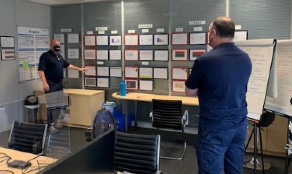It’s getting close to that frustrating time of year when business executives begin their strategic planning for the next calendar year only to realize they didn’t fully execute last year’s plan. “Two-thirds to three-quarters of large organizations struggle with execution,” according to a report in the Harvard Business Review.
Comparing with the other plants that are not in this pilot program, the difference is evident.
Vitor Vila Verde, Logoplaste’s global vice president of lean and strategy deployment
Not at Logoplaste. Executives at the company are gearing up for this year’s review and planning sessions with optimism. Last year, they adopted hoshin kanri as their strategic planning and deployment process at a few pilot plants, and, so far, they like what they see. “Comparing with the other plants that are not in this pilot program, the difference is evident,” declares Vitor Vila Verde, the company’s global vice president of lean and strategy deployment. He notes that he’s comparing plants with the same level of maturity in the number of years in operation.
Hoshin kanri is a way to set corporate business objectives that everyone in an organization fully understands and agrees with. It is also a method – a system — that ensures everyone makes progress toward achieving their part of the plan throughout the year. Critically, hoshin kanri aligns an organization’s functions and activities with its strategic objectives both vertically and horizontally. As a result, frontline operators know how their work contributes to corporate goals, and traditionally siloed departments – design, manufacturing, sales and marketing, logistics, etc. – are keenly aware of the handoffs from one to another.
Setting the Strategy
“One of the most differentiating factors of hoshin versus a traditional management-by-objectives or managing-by-budget is that we engage everyone at all levels and get alignment to set strategic priorities,” says Vila Verde. Traditional approaches tend to develop a strategy at the executive level, then cascade it down through the levels of the organization.
With hoshin, teams at each level, top to bottom, use a “catchball” process to determine what each needs to do – and needs from others — to improve and contribute towards achieving corporate objectives. This top-down and bottom-up dialog between managers and their teams forges agreement around the resources and time needed to achieve the targets.

“We get alignment at all levels in terms of what they need to improve, what they need to work on,” Vila Verde says. “We give ownership to the tactical teams, giving them the freedom to come up with ideas that will help us achieve the targets that we set for the next three years.”
Vila Verde adds that when Logoplaste started the process in the fourth quarter of 2020, they used the process to determine not only “what we are going to achieve but also how we are going to shift.”

For most companies, setting strategic objectives boils down to financials, and monitoring revolves around budget meetings. Leaders pore over spreadsheets and then often return to their teams with directives: cut costs 10% in the next three months! At Logoplaste, in addition to establishing a budget and financial growth goals, leaders set breakthrough objectives involving operations and, crucially, team capability development. Executing this broader approach requires a management system that informs each division and plant of their progress as it relays critical information to executive management. For Logoplaste, hoshin kanri is that system.
Executing the Strategy
While achieving full buy-in on objectives offers an organization a distinct competitive advantage, the more significant issue – execution – is where hoshin kanri excels. Built into the approach is a structure of cadenced meetings and practices that ensure everyone stays focused on achieving plan objectives.

For operations, Logoplaste sets breakthrough objectives, three to five strategic priorities, and the corresponding tactical targets to improve (TTIs) that each plant or region must achieve for the company to attain its objectives. Progress in meeting the targets is monitored with a series of meetings that continue the top-down, bottom-up dialog throughout the year. Vila Verde says the ongoing discussions are “a way to fight the silence culture,” adding that the alignment allows everyone to improve their work while working toward achieving the company’s goals that are shared by all.
Six months into the pilot, the cadence of meetings includes one meeting with each tactical team conducted two weeks before meeting with the board of directors. In between, Vila Verde coordinates monthly meetings with each team, and the teams review progress weekly.
 The tactical teams at each level also monitor their KPIs daily, says Vila Verde, “because if they are not able to sustain and stabilize their daily performance, you will never be able to raise the bar.” At each level, teams have a “control room” where they visually display and track results, plan and meet to discuss A3 reports. The A3 problem-solving methodology is how Logoplaste overcomes obstacles in the way of improvement.
The tactical teams at each level also monitor their KPIs daily, says Vila Verde, “because if they are not able to sustain and stabilize their daily performance, you will never be able to raise the bar.” At each level, teams have a “control room” where they visually display and track results, plan and meet to discuss A3 reports. The A3 problem-solving methodology is how Logoplaste overcomes obstacles in the way of improvement.
With this steady cadence of each leadership level going to the gemba, discussing issues, and helping as needed, everyone stays focused on achieving the objectives. The efforts and meetings are tracked with simple matrix tools.
As with any major transition in a large organization, Logoplaste’s adoption of hoshin kanri has required persistence to enact the change and a dedication to learning. Although Logoplaste leaders had extensive experience with lean thinking and practice, they sought support from the Lean Enterprise Institute at the start. Vila Verde attended the nonprofit’s Hoshin Kanri course when deciding which management system would help the company achieve its goals. He credits the course with helping him decide to move forward. “It was a very good experience to get this hoshin training, which is focused on the Toyota Hoshin way.”
Moving forward, the company plans to bring in support to help the teams learn the technical skills and help instill “the culture of being able to be outside of the comfort zone, that I call a Kaizen Culture or attitude,” Vila Verde says.
Part one of two. Read part two, Ensuring Success of Hoshin Kanri — a Better Way to Plan and Execute Your Strategy.
Managing a Lean Enterprise
Learn how to drive performance and inspire innovation using hoshin kanri, daily management, and A3 process.




